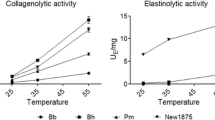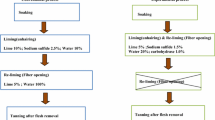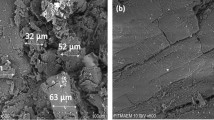Abstract
Objectives
The utilization of biotechnology in leather sector has more extensive in modern years; more particular to proteolytic enzymes and employed in several steps of the leather making such as soaking, dehairing, bating, solid waste management etc. The current study evaluates the performance of alkaline protease from Bacillus crolab MTCC 5468 in single soaking of goat skins matrix by comparing with the conventional multiple soaking processes.
Results
According to the obtained results, the optimum concentration for maximum rehydration of goat skins was accomplished at 1.0% (v/w) of alkaline protease at duration of 3 h over traditional rehydration method (4–6 h). The moisture level, total protein, chloride content and total organic carbon of enzymatic rehydration was superior to that of conventional rehydration and it was also used to measure the effectiveness of rehydration process. Scanning electron microscopic images of enzymatically processed leather exhibits enhanced opening of fiber bundles and smooth grain surface than conventional method. Furthermore, the alkaline protease treated leather exhibited improved moisture uptake, removal of chlorides and suppleness because of hydrolysis of non-collagenous proteins as indicated by well opened up fiber bundles in histological analysis.
Conclusions
The application of alkaline protease in rehydration operation of leather production confirmed scope for diminishing water quantity around 66.6%, soaking duration at 50%, minimizing use of harmful dehairing chemicals at 50–60%, thereby, eliminating the bating operation during pre-tanning. These outcomes suggest that alkaline protease have potential application in rehydration of skins for immense environmental concerns of leather tanning sectors.
Graphic abstract













Similar content being viewed by others
References
Ahmed Basha C, Soloman PA, Velan M, Balasubramanian N, Roohil Kareem L (2009) Participation of electrochemical steps in treating tannery wastewater. Ind Eng Chem Res 48:9786–9796
American Public Health Association (APHA) (1985) Standard methods for the examination of water and wastewater, 16th edn. Washington, DC, APHA
Bancroft JD, Gamble M (2004) Theory and practice of histological techniques. In: Jones ML, Totty BA (eds) Connective tissues and stains, 15th edn. Churchill Livingstone Publications, London, pp 139–200
Buljan J, Reich G, Ludvik J (1997) Mass balance in leather processing. IULTCS (International Union of Leather Technologists and Chemists Societies). Proceeding of a Conference on 11th–14th September 1997, London
Chen X, Penumadu D (2006) Review Characterizing microstructure of refractory porous materials. J Mater Sci 41:3403–3415
Clesceri LS, Greenberg AE, Trussell RR (1989) Standard methods for the examination of water and wastewater, 17th edn. American public health association, Washington, DC
De Souza FR, Gutterres M (2012) Application of enzymes in leather processing: a comparison between chemical and co-enzymatic processes. Braz J Chem Eng 29(03):473–481
Durga J, John Sundar V, Rose C, Muralidharan C (2019) Green processing: minimising harmful substances in leather making. Environ Sci Pollut Res 26(7):6782–6790
Fernando JA, Chung DDL (2002) Pore structure and permeability of an alumina fiber filter membrane for hot gas filtration. J Porous Mater 9:211–219
ISO:14268: (IULTCS/IUP15) (2012) Leather—physical and mechanical tests. Determination of water vapor permeability
IUC 8 (1998) Determination of chromic oxide content. J Soc Leather Technol Chem 82:200–208
IUP 16 (2000) Determination of shrinkage temperature. J Soc Leather Technol Chem 84:359
IUP 2 (2000) Sampling. J Soc Leather Technol Chem 84:303–309
Jianzhong M, Xueyan H, Dangge G, Bin L, Jing J (2013) Greener approach to efficient leather soaking process: role of enzymes and their synergistic effect. J Clean Prod 78(1):226–232
Kamini NR, Hemachander C, Geraldine J, Mala S, Puvanakrishnan R (1999) Microbial enzyme technology as an alternative to conventional chemical in leather industry. Curr Sci 77:80–86
Kandasamy N, Velmurugan P, Sundarvel A, Jonnalagadda RR, Bangaru C, Palanisamy T (2012) Eco-benign enzymatic dehairing of goat skins utilizing a protease from Pseudomonas fluorescens species isolated from fish visceral waste. J Clean Prod 25:27–33
Kunitz M (1947) Crystalline soybean trypsin inhibitor. J Gen Physiol 30:231–291
Lowry OH, Rosebrough NJ, Farr AL, Randall RJ (1951) Protein measurement with folin—phenol reagent. J Biol Chem 193:265–273
Maharaja P, Swarnalatha S, Saravanan P, Sekaran G (2019) Removal of fat components in high TDS leather wastewater by saline-tolerant lipase-assisted nanoporous-activated carbon. Appl Biochem Biotechnol 187:474–492
Mclaughlin GD, Theis ZR (1945) The chemistry of leather manufacture, vol 8. Reinhold publihing, Newyork, pp 158–160
Nielsen PH (2006) Environmental assessment of enzyme application in the tanning industry. Leather International August–September, pp 18–24
Ozgunay H, Colak S, Mutlu MM, Akyuz F (2007) Characterization of leather industry wastes. Pol J Environ Stud 16(6):867–873
Paul RG, Mohammed I, Davighi D, Addy VL, Covington AD (2001) The use of neutral protease in enzymatic unhairing. J Am Leather Chem Assoc 96:180–185
Ranjithkumar A, Durga J, Ramesh R, John sundar V, Rose C, Muralidharan C (2017a) Studies on alkaline protease from Bacillus crolab MTCC 5468 for applications in leather making. J Am Leather Chem Assoc 112:232–239
Ranjithkumar A, Durga J, Ramesh R, Rose C, Muralidharan C (2017b) Cleaner processing: a sulphide-free approach for depilation of skins. Environ Sci Pollut Res 24:180–188
Saikia P, Goswami T, Dutta D, Dutta NK, Sengupta P, Neog P (2017) Development of a flexible composite from leather industry waste and evaluation of their physico-chemical properties. Clean Technol Environ Policy 19(8):2171–2178
Sarkar KT (1991) Preparation of hides and skins for tanning. Theory and practice of leather manufacture. Oxford University Press, Oxford, p 99
Senthilkumar S, Balaji D, Surianarayanan M (2011) Optimization studies on production of a salt-tolerant protease from pseudomonas aeruginosa strain bc1 and its application on tannery saline wastewater treatment. Braz J Microbiol 42:1506–1515
Senthilvelan T, Kanagaraj J, Mandal AB (2012) Application of enzymes for dehairing of skins: cleaner leather processing. Clean Technol Environ Policy 14:889–897
Sharphouse JH (1983) Leather technician’s handbook. Leather Producers Association, Northampton, p 64
Thanikaivelan P, Raghava Rao J, Unni Nair B, Ramasami T (2005) Recent Trends in Leather Making: processes, Problems, and Pathways. Crit Rev Environ Sci Technol 35:37–79
Zambare VP, Nilegaonkar SS, Kanekar PP (2013) Protease production and enzymatic soaking of salt-preserved buffalo hides for leather processing. IIOAB Lett 3:1–7
Acknowledgements
The authors gratefully acknowledge the Council of Scientific and Industrial Research (CSIR), New Delhi for funding this research work and are thankful to the Director, CSIR—Central Leather Research Institute for his support. The author A. Ranjithkumar thank University Grants Commission—Rajiv Gandhi National Fellowship F1-17.1/2016-17/RGNF-2015-17-SC-TAM-17696/(SA-III/Website).
Author information
Authors and Affiliations
Corresponding author
Additional information
Publisher's Note
Springer Nature remains neutral with regard to jurisdictional claims in published maps and institutional affiliations.
Appendices
Appendix 1
The soaked goat skins from conventional were subjected to unhairing using 3% (w/w) sodium sulphide and lime 10% (w/w) whereas, partial unhairing chemicals (sodium sulphide 1.5% (w/w) and lime 5%(w/w)) were used for experimental skins. After unhairing all goat skins were relimed using 10% lime and 150% water for 48–72 h. These relimed goat skins were defleshed (sub-cutaneous tissues) using fleshing machine. After defleshing, the skins were delimed using 1% (w/w) ammonium chloride with 100% water (v/w) for 45 min in rotating drum, followed by treatment with 1% (w/w) alkali bate for 30 min in conventional method. After bating operation, the goat skins were washed two times and drained out. The washed skins were pickled using 8% (w/w) common salt and 80% (v/w) fresh water and run for 10 min followed by acidification using 0.5% (v/w) formic acid was mixed with 10% (v/w) water and given for 2 feeds at 10 min interval and run for 15 min, then 1% (v/w) sulphuric acid was mixed with 10% (v/w) water and given for 4 feeds at every 10 min intermission and the drum was additional run for 60 min. The final pH of pickled goat skin was 2.8 and the pickled skins were tanned using 8% (w/w) basic chromium sulphate (BCS) for 2 feed in half of the pickle bath for 90 min, then 50% (v/w) water was added and run for 30 min. After two feed of BCS, was basified using 1% (w/w) sodium formate was mixed with 10% (v/w) water and added to the rotating drum and then 1% (w/w) sodium bicarbonate was mixed with 10% (v/w) water and fed in 3 parts at 10 min intervals. Then, drum was continuously run for more than 60 min for additional fixing of tanning material. After chrome tanning operation, the pH of the both liquor and wet blue was observed to be 3.8.
Appendix 2
The wet blue leather was washed with 100% (v/w) water in a drum for 10 min, the water was drained out and wet blue leathers were treated with neutralizing syntan 1% (v/w) in 100% (v/w) float in a drum and run for 20 min. After this, 0.5% (w/w) sodium formate and 0.5% (w/w) sodium bicarbonate were added to the running drum in 3 feeds at 10 min time interval. After the liquor accomplished a pH of 5.0, the wet blue leathers were washed twice with water 200% (v/w) for 10 min. After completion of washing, 100% (v/w) water with 3% (w/w) resin syntan were added to the drum and run for 20 min. Followed by this, dying was carried out using 2% (w/w) acid dye for 30 min and fat liquoring was carried out with synthetic fat liquor 4% (w/w) in the drum for 30 min. Subsequently, melamine based re-tanning syntan 4% (w/w) was added and run for 40 min followed by the addition of synthetic fat liquor 4% (w/w), polymeric fat liquor 3% (w/w) and natural fat liquor oil 4% (w/w) and further running the drum for 40 min. Finally, the auxiliaries were leather was fixed using 2% (v/w) formic acid diluted with 20% (v/w) water and added at 3 feeds at every 10 min interval and the drum was further run for 30 min. After this, the leather was piled overnight and were subjected to setting and hooked for drying. The dried crust leathers were staked and buffed using 400 grit emery papers.
Rights and permissions
About this article
Cite this article
Ammasi, R., Victor, J.S., Chellan, R. et al. Alkaline protease for an efficacious rehydration of skin matrix by a novel Bacillus crolab MTCC 5468 in sustainable leather production: a green approach. Biotechnol Lett 42, 249–267 (2020). https://doi.org/10.1007/s10529-019-02769-0
Received:
Accepted:
Published:
Issue Date:
DOI: https://doi.org/10.1007/s10529-019-02769-0




